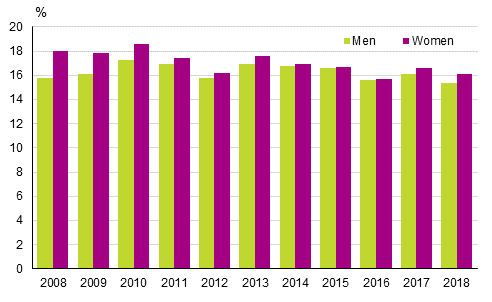Published: 27 March 2020
856,000 people were at risk of poverty or social exclusion in 2018
Statistics Finland's statistics on living conditions show that 856,000 Finns, or 15.8 per cent of the entire household population were at risk of poverty or social exclusion in 2018. The number of persons at risk fell by around 34,000 persons from the previous year, and the share was on the same level as in 2016. The number of persons at risk diminished in all dimensions of the indicator, for persons living in a low income household, in a household with low work intensity and those experiencing severe material deprivation.
Share of persons at risk of poverty or social exclusion by sex in 2008 to 2018

Being at risk of poverty or social exclusion means that the person is living in a low income household, a household with low work intensity or a household that experiences severe material deprivation. One of these risks materialising means that the person is at risk of poverty or social exclusion, but the risks can also be simultaneous. There were 640,000 persons living in low income households, 370,000 persons with low work intensity and 133,000 living in severe material deprivation in 2018.
A large group of persons at risk of poverty or social exclusion only live in a low income household. They numbered 406,000 persons or 7.5 per cent of the population and slightly under one-half of all persons at risk of poverty or social exclusion. The second most common situation was to experience both low income and low work intensity, which affects around 183,000 persons or 3.4 per cent of the population. Mere low work intensity is the third most common, and that applies to approximately 134,000 persons, or 2.5 per cent of the population.
Women were slightly more often than men at risk of poverty or social exclusion. In all, 16.1 per cent of women or 444,000 persons and 15.4 per cent of men or 412,000 were at risk of poverty or social exclusion in 2018. The difference is most of all due to living in a low income household which women (12.3%) experience slightly more often than men (11.2%). Experiences of low work intensity were somewhat more common among men (7.5%) than women (5.9%). Men also experience slightly more often than women a risk in more than one risk factor.
Living in low income households, low work intensity and severe material deprivation are all household-specific indicators. Thus observed gender differences in being at risk of poverty or social exclusion or its components mostly derive from differences between people living alone.
Of men at risk 66 per cent were of working age and only 15 per cent pensioners, while around 55 per cent of women at risk were of working age and 28 per cent pensioners. The lower number of female pensioners living in low income households has narrowed down the differences between women and men at risk of poverty or social exclusion compared to 2008, when 18 per cent of women and 15.8 per cent of men were at risk of poverty or social exclusion. During the past few years, the number of women living in low income households has again grown a little, which is also visible in the slightly bigger difference between women and men in being at risk of poverty or social exclusion. – More information on differences between population groups at risk of poverty or social exclusion is available in the database tables of the statistics on living conditions and data concerning low income is available in more detail in the income distribution statistics .
The so-called AROPE indicator (At Risk of Poverty or Social Exclusion) that measures the risk of poverty or social exclusion is part of the monitoring of the objectives of the Europe 2020 Strategy. It aims to reduce the number of persons living at risk of poverty or social exclusion in the EU by 20 million by 2020 compared with 2008, when there were 116 million people at risk of poverty or social exclusion. In 2017, altogether 110 million persons were at risk in 28 EU countries.
Households’ difficulties in making ends meet decreased in 2019
Fewer households than before had difficulties in making ends meet in 2019 1) . In all, 6.7 per cent of households had difficulties or great difficulties in making ends meet (figure). The share of households with difficulties in making ends meet has diminished in the past few years. It has been under eight per cent throughout the 2010s except for 2011.
In addition, 70 per cent of households also say that they could face unexpected expenses without outside help. The best prepared were pensioner households of two adults, around 89 per cent of whom could face unexpected expenses. The least prepared were one-supporter households (around 39%) and young one-person households (about 52%). Unexpected expenses refer to the sum corresponding to the monthly at-risk-of-poverty threshold for a one-person household, which in recent years has been around EUR 1,200.
Households with difficulties or great difficulties in making ends meet in 2004 to 2019, % of households and persons

1) Data are published in the statistics on living conditions according to two reference periods. The reference period for the risk of poverty or social exclusion is the year of income earning, but data based on interviews describe the time of the interview, that is, the year after the year of income earning. Further information on reference times is available in the quality description of this publication.
Source: Statistics on living conditions 2019, Statistics Finland
Inquiries: Kaisa-Mari Okkonen 029 551 3408
Director in charge: Jari Tarkoma
- Tables
-
Tables in databases
Pick the data you need into tables, view the data as graphs, or download the data for your use.
Updated 27.03.2020
Official Statistics of Finland (OSF):
Statistics on living conditions [e-publication].
01 2019. Helsinki: Statistics Finland [referred: 20.1.2026].
Access method: http://stat.fi/til/eot/2019/01/eot_2019_01_2020-03-27_tie_001_en.html

